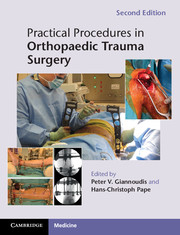Book contents
- Frontmatter
- Dedication
- Contents
- List of Contributors
- Preface
- Acknowledgements
- Part 1 Shoulder girdle
- Part 2 Upper extremity
- Part 3 Pelvis and acetabulum
- 8 Fractures of the pelvic ring
- 9 Section I: Fractures of the acetabulum
- Part 4 Lower extremity
- Part 5 Spine
- Part 6 Tendon injuries
- Part 7 Compartments
- Index
9 - Section I: Fractures of the acetabulum
Published online by Cambridge University Press: 05 February 2014
- Frontmatter
- Dedication
- Contents
- List of Contributors
- Preface
- Acknowledgements
- Part 1 Shoulder girdle
- Part 2 Upper extremity
- Part 3 Pelvis and acetabulum
- 8 Fractures of the pelvic ring
- 9 Section I: Fractures of the acetabulum
- Part 4 Lower extremity
- Part 5 Spine
- Part 6 Tendon injuries
- Part 7 Compartments
- Index
Summary
Indications
Posterior wall fractures.
Posterior column fractures.
Posterior column and wall fractures.
Transverse fractures.
Transverse posterior wall and T-shaped fractures.
Indications for emergency acetabular fracture fixation
Recurrent hip dislocation after reduction despite traction, progressive sciatic nerve deficit after closed reduction, irreducible hip dislocation, associated vascular injury requiring repair, open fractures.
Indications for acetabular fixation
Incongruent hip joint due to incarcerated fracture fragments (Fig. 9.1.1).
Ipsilateral femoral neck fractures.
Marginal impaction of the posterior wall.
Be aware that the roof-angle measurement criteria used as indications for fracture fixation in acetabulum fractures do not apply in the setting of pure posterior wall fractures.
Involvement of more than half of the posterior wall as defined on the CT scan ater comparison with the contralateral side.
When less than half of the posterior wall surface is involved, testing of the stability of the hip is recommended to deine unstable hips that merit surgical ixation.
Preoperative planning
Clinical assessment
Examination of the injured limb is essential, including the sot tissue envelope. Be aware of the Morel–Lavallée degloving injury of the posterior sot tissue envelope, which has a high rate of Staphylococcus epidermidis colonization with subsequent increased risk for infection.
In cases of high-energy trauma, examination for other potential associated injuries should be performed carefully.
The ATLS evaluation protocol should be followed.
- Type
- Chapter
- Information
- Practical Procedures in Orthopaedic Trauma Surgery , pp. 212 - 238Publisher: Cambridge University PressPrint publication year: 2014

